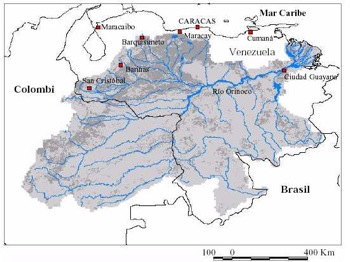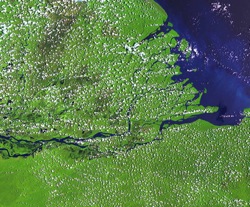Orinoco River
The Orinoco River is one of the longest rivers in South America at 2,140 km, (1,330 miles). Its drainage basin, sometimes called the Orinoquia (especially in Colombia) covers 880,000 km², 76.3% in Venezuela with the rest in Colombia. The Orinoco and its tributaries are the major transportation system for eastern and interior Venezuela and the llanos of Colombia. However, since river navigation is declining in every country, many of the old waterways along the Orinoco watershed are now an obstacle to land communications rather than a useful commercial route.
History
Although the mouth of the Orinoco in the Atlantic Ocean was discovered by Columbus on 1 August 1498 during his third voyage, its source at the Cerro Delgado-Chalbaud, in the Parima range, on the Venezuelan-Brazilian border, at 1,047 m of elevation ( [show location on an interactive map] 02°19′05″N 63°21′42″W / 2.31806°N 63.36167°W / 2.31806; -63.36167 ), was only explored in 1951, 453 years later, by a joint Venezuelan-French team.
The Orinoco delta, and tributaries in the eastern llanos such as the Apure and Meta, were explored in the 16th century by German expeditions under Ambrosius Ehinger and his successors. In 1531 Diego de Ordaz, starting at the principal outlet in the delta, the Boca de Navios, sailed up the river to the Meta, and Antonio de Berrio sailed down the Casanare, to the Meta, and then down the Orinoco and back to Coro.
Alexander von Humboldt explored the basin in 1800, reporting on the pink river dolphins, and publishing extensively on the flora and fauna.[1]
Geography
The Orinoco course describes a wide ellipsoidal arc, surrounding the Guiana Shield; it is divided in four stretches of unequal length that roughly correspond to the longitudinal zonation of a typical large river:
- Upper Orinoco, 242 km long, from its headwaters to the rapids Raudales de Guaharibos, flows through mountainous landscape in a northwesterly direction
- Middle Orinoco, 750 km long, divided into two sectors, the first of which ca. 480 km long has a general westward direction down to the confluence with the Atabapo and Guaviare rivers at San Fernando de Atabapo; the second flows northward, for about 270 km, along the Venezuelan - Colombian border, flanked on both sides by the westernmost granitic upwellings of the Guiana Shield which impede the development of a flood plain, to the Atures rapids near the confluence with the Meta River at Puerto Carreño,
- Lower Orinoco, 959 km long with a well developed alluvial plain, flows in a Northeast direction, from Atures rapids down to Piacoa in front of Barrancas
- Delta Amacuro, 200 km long that empties into the Gulf of Paría and the Atlantic Ocean, a very large delta (some 22.500 km² and 370 km at its widest).
At its mouth, the Orinoco forms a wide delta that branches off into hundreds of rivers and waterways that flow through 41,000 km² of swampy forests. In the rainy season the Orinoco can swell to a breadth of 22 kilometres and a depth of 100 meters.
Most of the important Venezuelan rivers are tributaries of the Orinoco, the largest being the Caroní, which joins it at Puerto Ordaz, close to the Llovizna Falls. A peculiarity of the Orinoco river system is the Casiquiare canal, which starts as an arm of the Orinoco, and finds its way to the Rio Negro, a tributary of the Amazon, thus forming a 'natural canal' between Orinoco and Amazon.
Major rivers in the Orinoco Basin
- Apure: from Venezuela through the east into the Orinoco
- Arauca: from Colombia to Venezuela east into the Orinoco
- Atabapo: from the Guiana Highlands of Venezuela north into the Orinoco
- Caroní: from the Guiana Highlands of Venezuela north into the Orinoco
- Casiquiare canal: in SE Venezuela, a distributary from the Orinoco flowing west to the Negro River, a major affluent to the Amazon
- Caura: from eastern Venezuela (Guiana Highlands) north into the Orinoco
- Guaviare: from Colombia east into the Orinoco
- Inírida: from Colombia southeast into the Guaviare.
- Meta: from Colombia, border with Venezuela east into the Orinoco
- Ventuari: from eastern Venezuela (the Guiana Highlands) southwest into the Orinoco
- Vichada: from Colombia east into the Orinoco
References
- Stark, James H. 1897. Stark's Guide-Book and History of Trinidad including Tobago, Granada, and St. Vincent; also a trip up the Orinoco and a description of the great Venezuelan Pitch Lake. Boston, James H. Stark, publisher; London, Sampson Low, Marston & Company. (This book has an excellent description of a trip up the Orinoco as far as Ciudad Bolívar and a detailed description of the Venezuelan Pitch Lake situated on the western side of the Gulf of Paria opposite.)
- MacKee, E.D., Nordin, C.F. and D. Perez-Hernandez (1998). "The Waters and Sediments of the Rio Orinoco and its major Tributaries, Venezuela and Colombia." United States Geological Survey water-supply paper, ISSN 0083; 2326/A-B. Washington: United States Government Printing Office.
- Weibezahn, F.H., Haymara, A. and M.W. Lewis (1990). The Orinoco River as an ecosystem. Caracas: Universidad Simon Bolivar.
- Rawlins, C.B. (1999). The Orinoco River. New York: Franklin Watts.
- Helferich, Gerard (2004) Humboldt's cosmos: Alexander von Humboldt and the Latin American journey that changed the way we see the world Gotham Books, New York, ISBN 1-59240-052-3
- Forero, Juan (1 June 2006) "For Venezuela, A Treasure In Oil Sludge" New York Times Vol. 155 Issue 53597, pC1-C6
- "Antecedentes y Sumario Paso a Nado Internacional de Los Rios Orinoco/Caroni" Paso Nado Internacional de Los Rios Orinoco y Caroní Official website in Spanish, translation of title: "Antecedents and Summary of the International Swim Meet of the Orinoco and Caroni Rivers"

